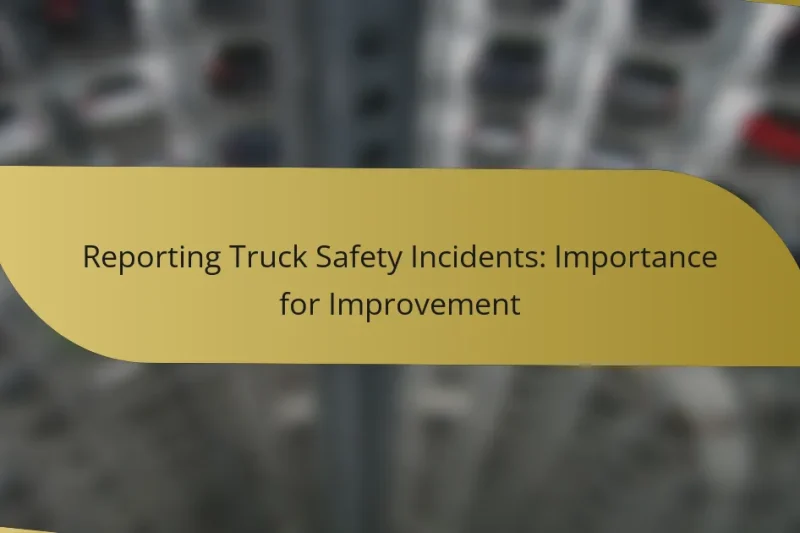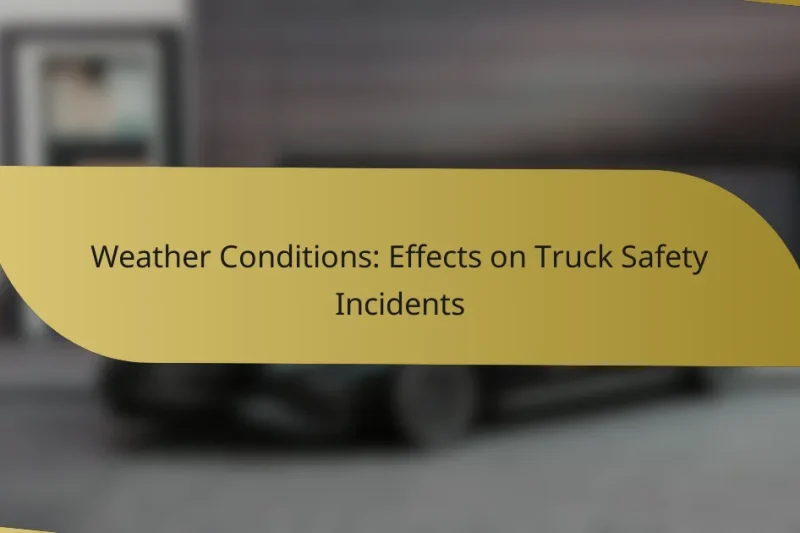Truck safety incidents in the United States can result in serious legal consequences, including liability for … Legal Consequences: Implications of Truck Safety IncidentsRead more
Truck Safety Reviews: Real-World Incidents
Truck safety is a critical concern on our roads, with incidents such as rear-end collisions, jackknife accidents, and rollovers posing significant risks. By analyzing real-world incidents, we can identify common safety violations and implement effective measures to enhance safety. Regular maintenance, driver training, and advanced safety technologies are essential components in reducing these risks and ensuring safer travel for everyone.
Driver Behavior: Impact on Truck Safety Incidents
Driver behavior is a critical factor influencing truck safety incidents, with unsafe practices often resulting in … Driver Behavior: Impact on Truck Safety IncidentsRead more
Reporting Truck Safety Incidents: Importance for Improvement
Effective reporting of truck safety incidents is essential for improving safety standards and preventing future accidents. … Reporting Truck Safety Incidents: Importance for ImprovementRead more
Weather Conditions: Effects on Truck Safety Incidents
Weather conditions play a crucial role in truck safety incidents, as they can drastically alter driving … Weather Conditions: Effects on Truck Safety IncidentsRead more
Truck Accidents: Common Causes in Urban Areas
Truck accidents in urban areas are often caused by a mix of factors such as driver … Truck Accidents: Common Causes in Urban AreasRead more
Truck Safety Incidents: Case Studies and Lessons Learned
Truck safety incidents pose significant risks on the road, often stemming from factors such as driver … Truck Safety Incidents: Case Studies and Lessons LearnedRead more
Load Weight: Influence on Truck Safety Incidents
Load weight plays a critical role in truck safety incidents, impacting vehicle handling, braking, and stability. … Load Weight: Influence on Truck Safety IncidentsRead more
What are the most common truck safety incidents?
The most common truck safety incidents include rear-end collisions, jackknife accidents, rollovers, load shifts, and pedestrian accidents. Understanding these incidents helps in implementing safety measures to reduce risks on the road.
Rear-end collisions
Rear-end collisions occur when a truck strikes the vehicle in front of it, often due to insufficient stopping distance or distracted driving. These incidents can lead to significant injuries and property damage, especially if the truck is large and heavy.
To prevent rear-end collisions, truck drivers should maintain a safe following distance, ideally at least four seconds behind the vehicle ahead. Regularly checking mirrors and being aware of traffic conditions can also help avoid these accidents.
Jackknife accidents
Jackknife accidents happen when the trailer swings out to the side of the truck, resembling a folding knife. This can occur during sudden braking or slippery road conditions, leading to loss of control and potential multi-vehicle collisions.
To minimize the risk of jackknife accidents, drivers should avoid abrupt braking and ensure that their trailer brakes are functioning correctly. Proper weight distribution and securing loads can also help maintain stability.
Rollovers
Rollovers occur when a truck tips over onto its side or roof, often due to sharp turns, high speeds, or uneven weight distribution. These accidents can be catastrophic, resulting in serious injuries or fatalities.
To prevent rollovers, truck drivers should adhere to speed limits, especially on curves, and ensure that loads are evenly distributed. Regular vehicle inspections can help identify potential issues that may lead to rollovers.
Load shifts
Load shifts happen when cargo inside a truck moves during transit, potentially causing instability and increasing the risk of accidents. This is particularly dangerous for trucks carrying hazardous materials or heavy loads.
To prevent load shifts, drivers should ensure that cargo is properly secured using straps, nets, or other restraints. Regular checks during long hauls can help identify any shifts that may occur and allow for necessary adjustments.
Pedestrian accidents
Pedestrian accidents involving trucks often result from limited visibility and the large blind spots that trucks have. These incidents can be devastating for pedestrians, especially in urban areas with heavy foot traffic.
To reduce the risk of pedestrian accidents, truck drivers should be vigilant at intersections and in crowded areas. Utilizing mirrors and cameras can help improve visibility, and drivers should always yield to pedestrians at crosswalks.
How can truck safety be improved?
Improving truck safety involves a combination of regular maintenance, effective driver training, and the integration of advanced safety technologies. Each of these elements plays a crucial role in reducing incidents and enhancing overall safety on the roads.
Regular maintenance checks
Regular maintenance checks are essential for ensuring that trucks operate safely and efficiently. These checks should include inspections of brakes, tires, lights, and other critical systems to identify potential issues before they lead to accidents.
Establish a maintenance schedule that adheres to manufacturer recommendations and industry standards. For example, many fleets perform checks every 5,000 to 10,000 miles, but this can vary based on usage and conditions.
Driver training programs
Comprehensive driver training programs are vital for enhancing truck safety. These programs should cover defensive driving techniques, hazard recognition, and proper vehicle handling to prepare drivers for various road conditions.
Consider implementing ongoing training sessions and refresher courses to keep skills sharp. Incorporating simulations and practical driving assessments can also help reinforce safe driving practices.
Advanced safety technologies
Integrating advanced safety technologies can significantly improve truck safety. Features such as lane departure warnings, automatic braking systems, and collision avoidance systems help prevent accidents and protect drivers and other road users.
Investing in these technologies can lead to lower insurance premiums and reduced liability costs over time. Evaluate options based on your fleet’s specific needs and consider the long-term benefits of enhanced safety features.
What are the legal implications of truck safety violations?
Truck safety violations can lead to significant legal consequences, including fines, penalties, and liability in accidents. Understanding these implications is crucial for truck operators and companies to ensure compliance and minimize risks.
Fines and penalties
Fines for truck safety violations can vary widely depending on the nature of the infraction and jurisdiction. For example, violations of federal regulations in the United States can result in fines ranging from hundreds to thousands of dollars per incident.
In addition to monetary fines, repeated violations may lead to increased penalties, including the potential suspension of operating licenses. Companies should regularly review their safety practices to avoid these costly repercussions.
Liability in accidents
Liability in accidents involving trucks often falls on the driver, the trucking company, or both, depending on the circumstances. If a truck is found to be in violation of safety regulations at the time of an accident, this can significantly increase the liability of the trucking company.
In many cases, victims of truck accidents can pursue compensation for damages, which may include medical expenses, lost wages, and pain and suffering. Trucking companies should maintain comprehensive insurance coverage and adhere strictly to safety regulations to mitigate potential liabilities.
What safety technologies are available for trucks?
Trucks are equipped with various safety technologies designed to enhance driver awareness and prevent accidents. Key systems include collision avoidance, electronic stability control, and lane departure warning systems, each contributing to safer driving conditions.
Collision avoidance systems
Collision avoidance systems use sensors and cameras to detect potential obstacles and alert the driver. If a collision is imminent, these systems can automatically apply the brakes to prevent or mitigate the impact.
These technologies are particularly beneficial in urban environments where sudden stops are common. Many systems can reduce the severity of accidents, potentially saving lives and reducing repair costs.
Electronic stability control
Electronic stability control (ESC) helps drivers maintain control of their vehicles during extreme steering maneuvers. By automatically applying brakes to individual wheels, ESC can prevent skidding and loss of control, especially in adverse weather conditions.
Trucks equipped with ESC are less likely to roll over, which is crucial given their size and weight. This technology is often mandated in many regions, including the European Union and the United States, enhancing overall road safety.
Lane departure warning systems
Lane departure warning systems monitor the truck’s position within its lane and alert the driver if the vehicle begins to drift without signaling. This technology helps prevent accidents caused by driver distraction or fatigue.
Some advanced systems can also provide lane-keeping assistance, gently steering the truck back into its lane if necessary. These features are especially useful on long-haul trips where driver fatigue can be a significant risk factor.
How do truck safety regulations vary by region?
Truck safety regulations differ significantly by region, influenced by local laws and federal guidelines. Understanding these variations is crucial for compliance and ensuring safe operations across state and national borders.
Federal Motor Carrier Safety Administration (FMCSA) regulations
The FMCSA establishes national standards for truck safety that apply to all commercial motor vehicles operating in the United States. These regulations cover various aspects, including driver qualifications, vehicle maintenance, and hours of service, which dictate how long drivers can operate without rest.
Key FMCSA regulations include the requirement for drivers to maintain a commercial driver’s license (CDL) and adhere to strict maintenance schedules. Additionally, the FMCSA mandates electronic logging devices (ELDs) to monitor driving hours, helping to prevent fatigue-related incidents.
State-specific regulations
In addition to FMCSA regulations, each state can implement its own safety regulations that may be more stringent. These can include specific weight limits, road usage fees, and additional training requirements for drivers. For example, some states may require special permits for oversized loads or have unique restrictions on certain routes.
Truck operators should familiarize themselves with the regulations in each state they operate in to avoid fines and ensure compliance. This includes checking for local laws regarding vehicle inspections, emissions standards, and safety equipment requirements, which can vary widely across the country.






